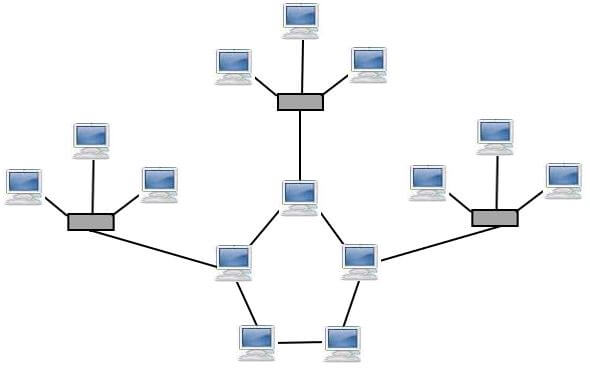What is Hybrid Topology?A hybrid topology is a kind of network topology that is a combination of two or more network topologies, such as mesh topology, bus topology, and ring topology. Its usage and choice are dependent on its deployments and requirements like the performance of the desired network, and the number of computers, their location. The below figure is describing the structure of hybrid topology that contains more than one topology. 
However, a variety of technologies are needed for its physical implementation, and it offers a complex structure. Also, it includes an advantage as increasing flexibility; it can increase fault tolerance, and allows new basic topologies to be added or removed easily. The hybrid topology is more useful when you need to fulfill diversity in Computer Network. In this topology, all network sections can include the configuration of different Network Topology. For instance, you can have a Hybrid network made by two different networks Star Backbone and the Ring Network. You can also use the Star Mesh Hybrid Topology in which if the main backbone gets fail, the entire network will destroy. Why Do We Use the Hybrid Topology?Due to effective cost, there are different applications that use hybrid topology. As compared to other fundamental mechanisms, the mechanism of hybrid topology is efficient; it can also be deployed in different environments. Thus, it provides users the benefit to create, run and manage the organization. There are various sectors where the hybrid topology is widely used, such as many educational institutions, banking sector, automated industries, financial sector, research organizations, ad multi-national companies. For creating the structure of the new hybrid topology, there is a need to mix any two topologies like full mesh topology, extended star, partial star, point to point networks is used. The examples and applications of hybrid topology are increasing rapidly. It has a super-power set up and flexible option and declared as a smart option; hence, the people choose to deploy it in-home or office. A compact is provided for the small-scale industries by this topology, as well as to their subunits. Thus, it is good to use for multi-floor buildings and departments such as an office or home. This topology is placed to give its maximum efficiency on the basis of the requirements as it provides many benefits. Types of hybrid topologiesThere are various types of hybrid topologies that integrate many basic topologies to make a new form of topology on the basis of the requirements. These topologies are hierarchical network topology, Star wire Ring network topology, and star wired bus topology. Like other basic network topologies, the hybrid topology's mechanism is also reliant on its IP address. But, in the functions of logic topology, there is a minor difference; it has its unique kind of configuration. The hybrid topology has the ability to integrate both types of topologies, physical and logical topology. There are various types of hybrid topology, which are discussed below: 1. Star-Ring hybrid topologyThe star topology and ring topology are used to create the structure of a star topology. Through a ring topology, two or more-star topologies are linked with the help of a wired connection. In the original ring topology, the data reaches a connecting node in this type of star topology. The method of data flow is unidirectional or bidirectional. In the original ring topology, the bidirectional method of data flow provides the surety that there is no effect on the whole network of data flow if one node of the original ring topology gets fails. 2. Star-Bus hybrid topologyA star-based bus topology is constructed by combining the two kinds of topologies that are star topology and bus topology. The bus topology allows two or more-star topologies to be linked to each other through wire connection. The original bus topology interrelates the distinct star topologies as it offers a backbone structure. That means it provides a wired connection. 3. Hierarchical Network TopologyThe structure of hierarchical network topology, also known as a network tree topology, is designed like a hierarchical tree. Its minimum level like two to a maximum level, and the maximum is called to the root or parent node. The next level of the structure of the hierarchical network topology includes a child node, which returns the child node as level three. Thus, except for the top-level nodes, every node provides a maximum parent node as they are at a required level. The nodes at the minimum level, peripheral nodes function like a parent for other nodes. These kinds of a node are called as leaf nodes. Advantages and Disadvantages of Hybrid topologyThere are multiple advantages of Hybrid Topology; such are discussed below:
There are also some disadvantages of hybrid topology, which are as follows:
Next TopicCache Memory vs Virtual Memory
|
 For Videos Join Our Youtube Channel: Join Now
For Videos Join Our Youtube Channel: Join Now
Feedback
- Send your Feedback to [email protected]
Help Others, Please Share









